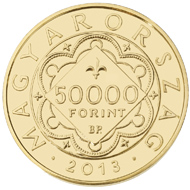September 19, 2013 – Hungary issues the second part of the collector series ‘Gold florins of Medieval Hungary’ depicting the golden florin of Louis I (1342-1382), thus honoring one of their great leaders from the medieval past. The first issue of the series was launched in 2012 about the first gold florin of Hungary issued by King Charles I (1288-1342).
Hungary / 50,000 HUF / Au .986 / 20 mm / 3.491 g / Design: E. Tamas Soltra / Mintage: 3,000.
The coin’s obverse depicts a lozenge shaped shield within a hexafoil decorated with Anjou-lilies. The reverse shows the golden florin of Louis I bearing the St. Ladislaus motif. A piefort version of the coin – with same design and diameter, but weighing 13.964 g – is also issued. The piefort version bears the legend ‘+LODOVICI DEI GRATIA REGIS UNGARIAE’ on the edge.
Louis of Anjou, King of Poland and Hungary. Source: Wikipedia.
Louis the Great (1342-1382), son of Charles I from the Italian branch of the house of Anjou and Elizabeth Piast of Poland, was crowned king of Hungary on 21st July 1342 in Szekesfehervar at the age of 16. He inherited from his father a politically stable, economically balanced realm, along with a rich treasury; as a result, the Kingdom of Hungary grew to be a truly great power under his reign, in the region of Central Europe and beyond.
Louis I essentially followed his father’s financial and economic policies, but at the same time he introduced a number of changes. His reforms were most visible in the field of financial administration, but his name is also associated with the creation of the golden florin and its particular Hungarian appearance.
Minting of gold coins began in Hungary in 1325; at first the coins’ appearance and standard were modelled on Florentine patterns. Starting from 1350s, the traditional forms of the coins were intentionally transformed in several steps. The first gold coins issued by Louis I were identical in appearance to the florin gold coins issued by his father: the obverse featured a Florentine fleur-de-lis, with a depiction of St. John the Baptist on the reverse.
In the second step, the fleur-de-lis on the obverse was replaced by an escutcheon party per pale containing the arms of Hungary and the house of Anjou inside a hexafoil, thus uniting the arms of the country (Hungarian stripes) and the royal house (Angevin fleurs-de-lis). Thus, the obverse of the coin departs from the Florentine pattern, while the reverse still featured St. John the Baptist. The process of change was completed with a coin, the reverse of which depicted Hungarian King Saint Ladislaus, who was revered by Louis I. Saint Ladislaus holds in his right hand his main attribute, the battle-axe, and the orb in his left hand, with a halo around his crowned head.
The new gold florins were produced in several mints, including Buda, Körmöcbanya (present-day Kremnica in Slovakia) and in Transylvania, probably in Kolozsvar (present-day Cluj-Napoca in Romania). The privy mark ‘P’ between the saint’s legs on this coin indicates that this piece was likely struck in the mint of Buda in the 1360s, under chamberlain Petrus Chimle.
The rosettes on the two sides of the saint are not merely decorative, but probably also function as emission marks. These gold florin coins with their particular Hungarian appearance were also very popular beyond Hungary’s borders, and variations on the Hungarian St. Ladislaus motif began to appear on other coins in Europe, just as the Florentine patterns had been copied in the past. The motif of St. Ladislaus lived on long after the reign of Louis I, and Hungarian gold florin coins bearing his image on the reverse were still being minted as late as the end of 16th century.
For more information on the collector coin please visit the Mint’s website.
About the genealogy of the Kings of Hungary you can read in detail here.







